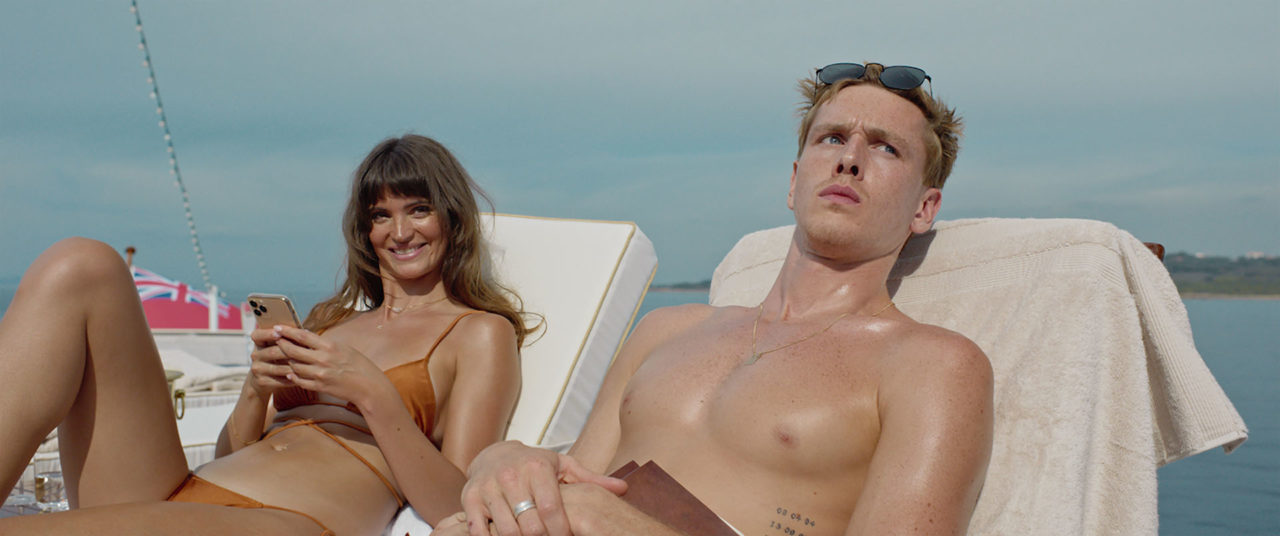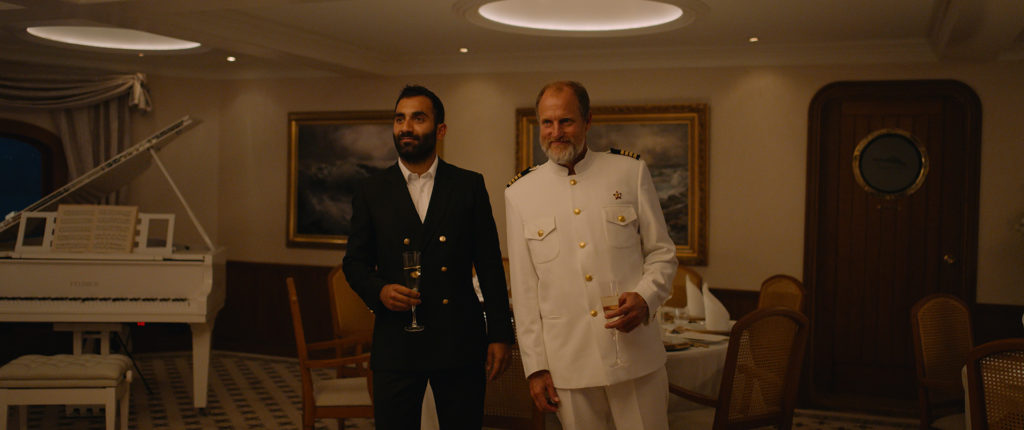The Aesthetics of Capitalism, (Somewhat) Deconstructed
A scattered satire molded from reality TV. A still from Ruben Östlund's film, "Triangle of Sadness."
A still from Ruben Östlund's film, "Triangle of Sadness."
Triangle of Sadness
Dir. by Ruben Östlund
Everything is transactional. At least, that’s the mantra with which Swedish satirist Ruben Östlund approaches his latest comedy, “Triangle of Sadness.” As zany as it is haphazard, the tri-pronged narrative maintains the “Force Majeure” and “The Square” director’s penchant for pushing people until they break, even if it doesn’t fully coalesce.
Marketed as a story about a luxury yacht trip gone awry, the movie’s seafaring section is actually a distinct middle chapter. It arrives sandwiched between segments that, while featuring many of the same characters, play out like tales connected by the themes of wealth and the blockades they form between us. Each of the three chapters draws from the flashy world of modern reality television. The first begins with a ludicrous series of catwalk auditions, like something ripped from “America’s Next Top Model,” before diving behind the scenes to capture the drama quietly unfolding in the personal life of up-and-coming male model Carl (Harris Dickinson). Carl’s uncomfortable conversations about money with his successful supermodel girlfriend Yaya (the late Charlbi Dean) are the segment’s dramatic centerpiece. Though the pair are nominally a couple, the relationship is only for the public eye, and will likely last only so long as it benefits their careers.
Marketed as a story about a luxury yacht trip gone awry, the movie’s seafaring section is actually a distinct middle chapter.
The second chapter unfolds in the mold of the “Below Deck” franchise, a series that follows the staff of fancy sailing vessels and exposes the guts of the luxury tourism industry. Carl and Yaya are social media influencers invited aboard one such luxury yacht. There they encounter a multitude of colorful characters, most notably the disheveled Russian oligarch, Dimitry (Zlatko Burić), and the ship’s drunk American captain, Thomas Smith (Woody Harrelson). Smith also happens to be a communist, providing the source of conflict with Dimitry. When the yacht runs aground, the movie’s third and final chapter finds a handful of survivors — wealthy guests, front-facing European yacht staff and a member of the Filipino cleaning crew — stranded on a desert island and forced to create a new world from the detritus of the old. This final act is “Survivor” without the cameras or the producorial edicts; a tongue-in-cheek “Lord of the Flies” that’s unambiguous about its social allegories, but far less viscerally funny than the film’s preceding chapter.

The third Östlund satire to garner critical acclaim in recent years, “Triangle of Sadness” is the least cohesive of the bunch. “Force Majeure,” which won the 2014 Un Certain Regard jury prize at Cannes, was a blistering takedown of masculinity about a father accused of abandoning his family mid-avalanche. It walked a fine line between laughs and razor-sharp intensity. His follow-up was the 2017 Palme d’Or winning “The Square,” an investigation into free expression set against the high-class world of museum curation. Rather than following straightforward plots, both films are composed of loosely-strung vignettes orbiting a central theme. “Triangle of Sadness” exists, theoretically, in that same vein, and it won Östlund his second Palme at Cannes.
“Triangle of Sadness” completes Östlund’s triptych about men and money, but with a looseness that feels like aloofness. It lacks the rigorous thematic throughlines of “Force Majeure” and “The Square,” with a third act that feels like a minor deflation, dialing down the film’s absurdities in favor of more literal and didactic extrications.
The third Östlund satire to garner critical acclaim in recent years, “Triangle of Sadness” is the least cohesive of the bunch.
In its first two chapters, “Triangle” places Carl’s masculinity at odds with the ladder of success, imbuing the film with Östlund’s signature awkward tones. Carl knows, full well, that Yaya wields more money, boasts more Instagram followers and garners more attention from onlookers, three different forms of currency that trigger his insecurities. Their relationship, while it bears resemblance to real romance (they seem to have a mutual affinity), is a business deal first and foremost, but it also comes off as the most genuinely caring dynamic aboard the yacht. Old and middle-aged married couples fill the fancy dining room seats (along with a few older rich men and younger trophy women), but their stilted interactions lure the invisible specter of wealth into every frame. It makes us wonder: Why are any of these people together in the first place?
Compounding the awkwardness is the eagerness with which the yacht’s all-white staff — led by their manager Paula (Vicki Berlin) — grovel at the feet of the all-white guests, if it means a chance at heftier tips. Paula’s interest in maintaining the status quo is further explored in the third chapter’s quiet deconstruction of class and labor, based around a handful of guests’ reliance on the ship’s unseen sanitation workers — especially a middle-aged Filipina woman named Abigail, played by a fearsome Dolly de Leon — for everything from food to shelter. But while these scenes are dramatically impressive, in that they allow de Leon to explore the contours of the very power she was once denied, they never achieve the aesthetic heights of the film’s riveting, hilarious middle segment, which crescendos in perhaps the most absurd demolition of one-percenter privilege ever put to screen.
“Triangle of Sadness” completes Östlund’s triptych about men and money, but with a looseness that feels like aloofness.
The central concerns of “Triangle of Sadness” are the gaudy aesthetics of wealth, and the visual allure of glamor as we experience it through screens of all sizes. It’s a dynamic the film establishes with laser precision from its “Zoolander”-esque opening scene, when a reporter eggs on a gaggle of male models to show off their Balenciaga and H&M faces for the camera, alternating pouts and smiles that signal the levels of prestige represented by different brands. The distinctions are ones we instinctively understand, and Östlund revels in their arbitrariness. This theme of maintaining class as an aesthetic first and foremost is embodied in the characters of Carl and Yaya, status-impersonators who cling to their delusions, but whose surface allure sees them readily accepted by the one percent even as they go down with the (luxury) ship.
Ultimately, “Triangle of Sadness” can be understood as a “Titanic” parody. Upon its rotating stages, a cast of wealthy characters struggle to maintain their upper-class veneers at all cost, even as the floor falls out from under them to reveal an angry and equalizing sea. The magnificent, gut-busting climax — featuring gold-laced vomit from some of the final supper’s fancy dishes — mock and expose the pretensions and signifiers of class more bitingly than anything in the rest of the film. Had “Triangle of Sadness” ended there, it might have been a masterpiece.
Your support matters…Independent journalism is under threat and overshadowed by heavily funded mainstream media.
You can help level the playing field. Become a member.
Your tax-deductible contribution keeps us digging beneath the headlines to give you thought-provoking, investigative reporting and analysis that unearths what's really happening- without compromise.
Give today to support our courageous, independent journalists.
You need to be a supporter to comment.
There are currently no responses to this article.
Be the first to respond.